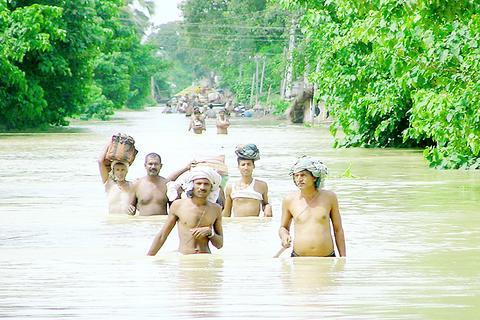Landslides triggered by heavy rains buried at least 12 people in their homes while six people drowned in surging river waters as floods rav-aged parts of South Asia yesterday.
More than seven million people have been marooned or left homeless in villages and towns across eastern India, Nepal and Bangladesh after annual monsoon floods inundated large tracts of land.
Government helicopters brought packages of food and relief material such as tarpaulin sheets to thousands of villagers in Nepal and India where thousands were stranded on rooftops.

PHOTO: AFP
Close to 170 people have died in densely-populated South Asia since the start of July as heavy monsoon rains set off landslides and caused dozens of rivers to overflow.
Officials in India's Assam state, where two million people have lost their homes because of flooding, said they found it hard to cope with the sheer scale of flooding.
"The state is not adequately equipped to handle the rescue and relief operations," said Tarun Gogoi, the chief minister who appealed for international assistance on Monday.
People negotiated flooded areas of Assam in boats made from the trunks of banana trees and bamboos, and loaded with clothes and cooking utensils.
In some flooded areas of Bangla-desh, overflowing rivers submerged crops and cut rail and road links, pushing up food prices.
Twenty-five of the country's 64 districts have been hit by flooding and millions marooned. Officials fear outbreaks of water-borne diseases as thousands of drinking wells have been submerged.
Most of the deaths were in Nepal, where 12 people were killed in landslides in the east, pushing to 48 the impoverished nation's death toll from landslides, drowning and snake bites this season. Floodwaters have washed away bridges and felled electrical lines, although in other areas waters were receding.
"Though water levels have fallen, people are scared to return home as they fear their mud and brick houses will collapse," resident Brij Kumar Yadhav said in Janakpur, 450km east of Kathmandu.
The region's monsoon, which has yet to provide good rains to south and central India, is vital for the farm-dependent economies.
About 3.7 million people have been displaced with an estimated 3,200 villages under water, a flood control official said.
The Brahmaputra River, which criss-crosses the state of Assam, was flowing at least 1.5m to 2.6m above the danger level.
"We are trying our best to provide food and medicines to the victims. But then as we all know, it is next to impossible to meet the needs of millions of flood-hit people," Assam Health Minister Bhumidhar Barman said.
Floods and landslides have also hit the neighboring Himalayan kingdom of Bhutan, where a dozen bridges have been washed away.
Meanwhile, floodwaters Tuesday entered the Kaziranga Wildlife Sanctuary in Assam, forcing scores of endangered animals to flee.
The 430-square-kilometer park east of Guwahati is home to the world's largest concentration of one-horned rhinoceros. There are an estimated 1,600 rhinos at Kaziranga out of a total world population of some 2,300.
"Herds of elephants, deer, wild buffaloes and rhinos from the park are migrating to an adjoining hill for safety," another park official said.
Park officials said they were also worried about poachers killing animals, especially rhinos and elephants, as the animals move out of the sanctuary.

A fire caused by a burst gas pipe yesterday spread to several homes and sent a fireball soaring into the sky outside Malaysia’s largest city, injuring more than 100 people. The towering inferno near a gas station in Putra Heights outside Kuala Lumpur was visible for kilometers and lasted for several hours. It happened during a public holiday as Muslims, who are the majority in Malaysia, celebrate the second day of Eid al-Fitr. National oil company Petronas said the fire started at one of its gas pipelines at 8:10am and the affected pipeline was later isolated. Disaster management officials said shutting the

US Vice President J.D. Vance on Friday accused Denmark of not having done enough to protect Greenland, when he visited the strategically placed and resource-rich Danish territory coveted by US President Donald Trump. Vance made his comment during a trip to the Pituffik Space Base in northwestern Greenland, a visit viewed by Copenhagen and Nuuk as a provocation. “Our message to Denmark is very simple: You have not done a good job by the people of Greenland,” Vance told a news conference. “You have under-invested in the people of Greenland, and you have under-invested in the security architecture of this

UNREST: The authorities in Turkey arrested 13 Turkish journalists in five days, deported a BBC correspondent and on Thursday arrested a reporter from Sweden Waving flags and chanting slogans, many hundreds of thousands of anti-government demonstrators on Saturday rallied in Istanbul, Turkey, in defence of democracy after the arrest of Istanbul Mayor Ekrem Imamoglu which sparked Turkey’s worst street unrest in more than a decade. Under a cloudless blue sky, vast crowds gathered in Maltepe on the Asian side of Turkey’s biggest city on the eve of the Eid al-Fitr celebration which started yesterday, marking the end of Ramadan. Ozgur Ozel, chairman of the main opposition Republican People’s Party (CHP), which organized the rally, said there were 2.2 million people in the crowd, but

JOINT EFFORTS: The three countries have been strengthening an alliance and pressing efforts to bolster deterrence against Beijing’s assertiveness in the South China Sea The US, Japan and the Philippines on Friday staged joint naval drills to boost crisis readiness off a disputed South China Sea shoal as a Chinese military ship kept watch from a distance. The Chinese frigate attempted to get closer to the waters, where the warships and aircraft from the three allied countries were undertaking maneuvers off the Scarborough Shoal — also known as Huangyan Island (黃岩島) and claimed by Taiwan and China — in an unsettling moment but it was warned by a Philippine frigate by radio and kept away. “There was a time when they attempted to maneuver